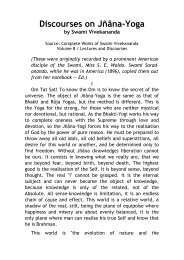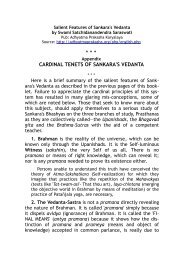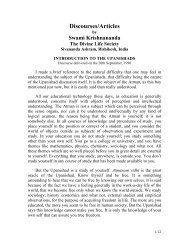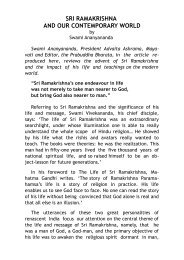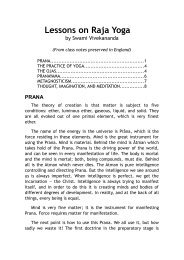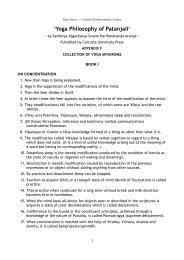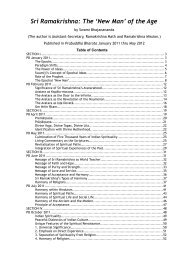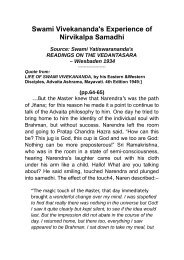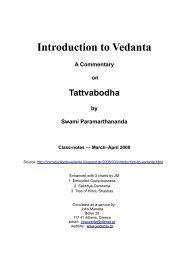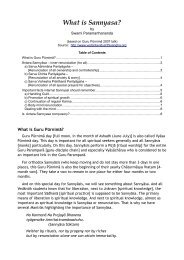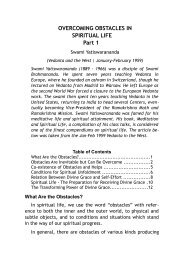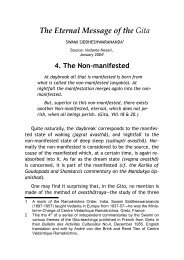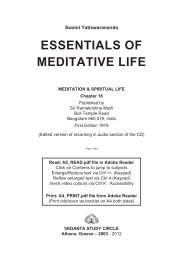Gita Summaries: Chapters 1-11 - Vedanta
Gita Summaries: Chapters 1-11 - Vedanta
Gita Summaries: Chapters 1-11 - Vedanta
Create successful ePaper yourself
Turn your PDF publications into a flip-book with our unique Google optimized e-Paper software.
Swami Paramarthananda on <strong>Gita</strong> – <strong>Summaries</strong> of Chaps 1-<strong>11</strong><br />
Do something physical (Bang a pillow, clean the house, go to the beach and shout)<br />
Keep the mouth engaged (drink water or have a gum!!!)<br />
b) Suppressed anger can lead to psychosomatic illness. Find the cause of anger. Each<br />
time you fight with someone on a trivial matter and start dating back to 1985<br />
incidents, it means that these conflicts have not be resolved.<br />
Kama jayah means not expecting anything from this world; any expectation leads to<br />
desire and then the chain of samsara.<br />
The next disciplines Lord Krishna mentions are:<br />
- Sravanam (where you only receive knowledge from a guru and no questions; just<br />
have faith in guru and scriptures). Systematic and consistent study on these 7<br />
subjects: nature of jiva, nature of world, nature of god, what is bondage, causes of<br />
bondage, what is liberty and causes of liberty.<br />
- Mananam (reflect on the teaching and ask questions humbly to clear doubts; this is<br />
at an intellectual level)<br />
- Nididhyasanam (assimilation of knowledge at an emotional level; there should not<br />
be even 1% doubt. Any doubtful knowledge is no knowledge at all; will you ever touch<br />
a live-wire which is probably 99% safe).<br />
Chapter 6 — Atmasyanyama-yogah<br />
(The Yoga of Self-Control)<br />
Tuesday, May 26, 2009<br />
The essence of the <strong>Gita</strong> and the essence of the Vedas is the same; which is moksha alone<br />
is Parama Purushartha [Supreme Goal]. It does also talk of Artha/Kama/Dharma but<br />
these are secondary purusharthas. Therefore we can conclude that <strong>Gita</strong> is moksha<br />
sadhana [means to liberation] only.<br />
Jnanam is the only means of moksha praapti [attainment]. Arjuna in the battlefield<br />
faces the problem of Ragah–Duhkha–Moha; which is nothing but dependence on external<br />
factors. Sorrow arises when the external factors are not favourable. The mind is<br />
overpowered by attachment and greed, and the intellect clouded. It sees dharma as<br />
adharma and vice versa. Attachment- grief- conflict is a vicious cycle.<br />
One must understand clearly that material acquisitions do not solve the problem; wasn’t<br />
Arjuna wealthy, skilled, and possessed everything that a person can aspire for. In spite of<br />
all these worldly achievements, he is not able to overcome sorrow and even<br />
contemplates suicide. Therefore, worldly accomplishments do not solve grief.<br />
Arjuna does a very intelligent thing; he falls at the feet of the Lord; Please instruct me<br />
and take me as your disciple. So, <strong>Gita</strong> is a guru-shishya samvadah only. Never attempt to<br />
gain self-knowledge independently, be humble enough to approach a guru.<br />
We soon realize that bondage is never there; it is only self-hypnosis, self-deception, self-<br />
16



